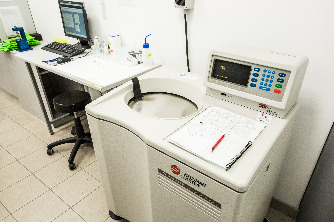View All Molecular Biophysics at Instruct
The platform at the Biomolecular Interactions and Crystallography core facility (BIC) at CEITEC Instruct centre provides instruments and services leading to the biophysical characterization of (bio)molecules, the study of biomolecular interactions (determination of affinity, kinetic and thermodynamic parameters) and the sample quality control using analytical ultracentrifugation (AUC), isothermal titration calorimetry (ITC), surface plasmon resonance (SPR), bio-layer interferometry (BLI), microscale thermophoresis (MST), dynamic light scattering (DLS), differential scanning calorimetry (DSC), differential scanning fluorimetry (DSF), and analytical size-exclusion chromatography (SEC-MALS). The platform is available to the entire INSTRUCT-ERIC community every working day upon previous agreement.
More information can be found on the Biomolecular Interactions and Crystallography core facility webpage
Size exclusion chromatography is a method that separates molecules based on their size. It is based on a different retention of the molecules on a column with inert filling at a steady flow. When coupled to an array of detectors, it enables also a detailed analysis of composition of individual elution peaks. In the case of OmniSEC instrument, the detected features include refractive index, UV-VIS spectrum, static light scattering and intrinsic viscosity. This enables analysis of various types of samples, such as proteins and their complexes, nucleic acids, polysaccharides and nanoparticles. High pressure chromatography (1-20 MPa) ensures good separation of individual species, e.g. protein oligomers. Instrument: OmniSEC (Malvern) More information on the instrument and the sample requirements can be found here.
Analytical ultracentrifugation (AUC) is a powerful technique for the characterisation of biomolecules and their interactions in a solution. It is applicable to proteins, nucleic acids, lipids, polysaccharides, viruses and nanoparticles. Analytical ultracentrifugation is used to determine the degree of the sample heterogeneity, the oligomeric state (or molar mass, respectively), the shape of the particle and to characterize biomolecular interactions (stoichiometry, Kd). Instrument: ProteomeLab XL-I (Beckman Coulter). More information on the instrument and the sample requirements can be found here.
Bio-layer interferometry is a method that measures biomolecular interactions on a surface in real time. One interacting partner is immobilized on the surface of sensor tip while the second one is in solution. The binding is detected via fiber optics as a change in interference pattern of light reflecting from the sensor surface. Similarly to surface plasmon resonance, it enables to determine the binding kinetics, affinities and also perform the quantification experiments. The main advantages of BLI technique are virtually no sample consumption (measurement directly in plates), high speed and possibility to perform the measurement also in highly heterogeneous environment (such as blood plasma). Instrument: Octet RED96e (Forte Bio) More information on the instrument and the sample requirements can be found here.
Circular dichroism spectroscopy measures differences in the absorption on left and right - handed polarised lite that arrise from the structural assymetry (presence in chiral atoms in the molecule). CD spectroscopy is used to investigate the secondary structure of proteins α-helices, β-strands and randome coils can be identified in the fare UV region where thay give rise to characteristic shape and magnitude of the spectrum. Instrument: J-815 (Jasco) More information on the instrument and the sample requirements can be found here.
Differential scanning calorimetry (DSC) measures the heat changes that occur in the sample during a controlled increase or decrease in temperature, and provides an insight into the stability of the biomolecule and the mechanisms of folding and unfolding. It allows an accurate determination of the transition midpoint (Tm), the enthalpy (ΔH) and the change in heat capacity (ΔCp) of the process. Typical applications include determination of the protein stability and the thermodynamics of unfolding. Technique is also suitable for the characterization of membranes, lipids, nucleic acids and micellar systems. Instruments: VP-DSC (Malvern), Auto PEAQ-DSC (Malvern) More information on the instrument and the sample requirements can be found here.
Differential scanning fluorimetry (DSF) is used to determine the thermal and chemical stability of the biomolecules. In contrast to conventional DSF methods, the nanoDSF technology uses the intrinsic tryptophan or tyrosine fluorescence to monitor the protein unfolding/refolding and determine the transition midpoint (Tm). The advantages of nanoDSF are high-throughput, low sample consumption and no need to add an external dye. Instrument: Prometheus NT.48 (Nanotemper) More information on the instrument and the sample requirements can be found here.
Dynamic light scattering (DLS) measures the fluctuations of the scattered light and provides the information on the sample polydispersity and the hydrodynamic radii of the particles. DLS is also a very sensitive technique for detection of aggregates in the sample and a suitable tool for buffer optimization and sample quality checks prior to the crystallization. DLS is applicable to biomolecules, viruses, liposomes, polymers, micelles and nanoparticles. Instruments: DelsaMax Core (Beckman Coulter), SpectroLight 600 (Xtal Concepts, plate reader) More information on the instrument and the sample requirements can be found here.
Isothermal titration calorimetry (ITC) is used to measure the binding affinity and thermodynamics of a wide variety of biomolecular interactions (those including e.g. proteins, nucleic acids, lipids or small ligands), and to study the enzyme kinetics. ITC measures the heat released or absorbed during the binding event and a complete thermodynamic profile of the interaction can be obtained in a single experiment (stoichiometry, Kd, ∆H and ∆S). ITC requires no labeling, accommodates wide range of affinities and the measurement can be performed over a range of conditions (temperature, ionic strength, pH, etc.). Instrument: The platform offers both the manual (VP-ITC, Malvern) and the automated, high-throughput calorimeter (PEAQ-ITC Automated, Malvern). More information on the instrument and the sample requirements can be found here.
Microscale thermophoresis (MST) is based on measuring changes of the mobility of molecules in the microscopic temperature gradients. It allows for determination of affinity and stoichiometry of the biomolecular interactions. The interaction is measured through the changes in hydration shell, charge or size of the fluorescently-labeled molecule. MST can be used for measuring interactions between molecules of different sizes and masses (ions to viruses) with a very low sample consumption. Instruments: Monolith NT.115 (Nanotemper), Monolith NT.115 Pico (Nanotemper) More information on the instrument and the sample requirements can be found here.
The SPR biosensor system exploits the phenomenon of surface plasmon resonance to monitor the interactions between molecules in a real time. One of the binding partners is immobilized on the sensor chip surface, while the other is passed over the surface in a solution. SPR method is used to determine the specificity, affinity and kinetics of the interaction. The method finds its application in different fields of science, e.g. in structural biology or biotherapeutic and drug discovery research. Instrument: Biacore T200 (GE Healthcare) More information on the instrument and the sample requirements can be found here.
More information can be found on the platform webpage.


